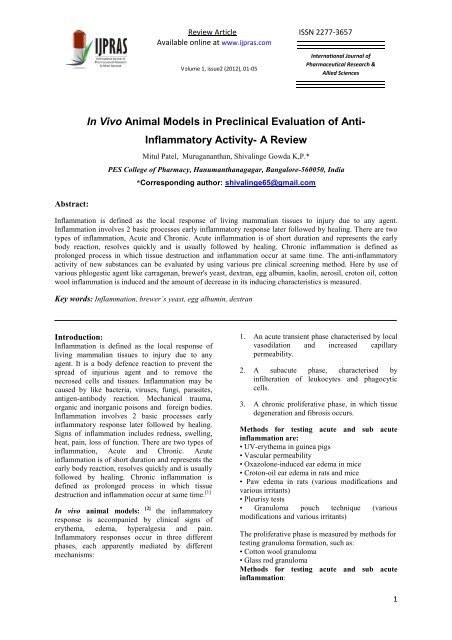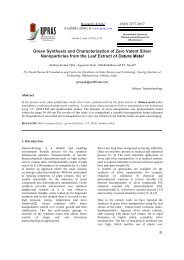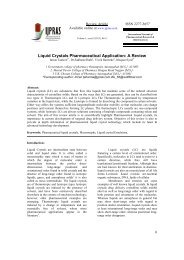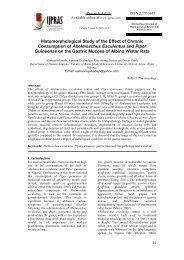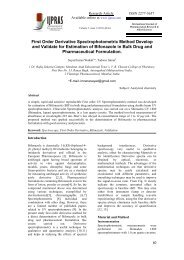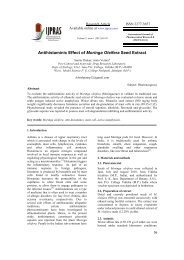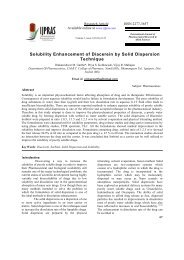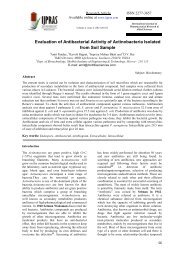In vivo animal models in preclinical evaluation of anti-inflammatory ...
In vivo animal models in preclinical evaluation of anti-inflammatory ...
In vivo animal models in preclinical evaluation of anti-inflammatory ...
You also want an ePaper? Increase the reach of your titles
YUMPU automatically turns print PDFs into web optimized ePapers that Google loves.
Available onl<strong>in</strong>e at www.ijpras.comcarrageenan (1%). After 4 h the <strong>animal</strong>s were killedwith an overdose <strong>of</strong> ether, the thorax was openedand the pleural cavity was washed with 1.0 ml <strong>of</strong>sterile PBS, conta<strong>in</strong><strong>in</strong>g hepar<strong>in</strong> (20 IU per ml).Samples <strong>of</strong> the pleural lavage were collected fordeterm<strong>in</strong>ation <strong>of</strong>exudation, myeloperoxidase ,adenos<strong>in</strong>e-deam<strong>in</strong>ase activities, and nitric oxidelevels, as well as for determ<strong>in</strong>ation <strong>of</strong> total anddifferential leukocyte counts . Total leukocytecounts were performed <strong>in</strong> a Neubauer chamber.The cytosp<strong>in</strong> preparations <strong>of</strong> pleural wash weresta<strong>in</strong>ed with May–Grunwald Giemsa for thedifferential count which was performed under anoil immersion objective. The serum level <strong>of</strong> the C-reactive prote<strong>in</strong> was also analysed. <strong>In</strong> another set <strong>of</strong>experiment <strong>animal</strong>s were treated 30 m<strong>in</strong> beforecarrageenan with a solution <strong>of</strong> Evans blue dye (25mg/kg, i.v.) <strong>in</strong> order to evaluate the degree <strong>of</strong>exudation <strong>in</strong> the pleural space. A sample (500 µl)<strong>of</strong> the fluid leakage collected from the pleuralcavity was stored <strong>in</strong> a freezer (−20 °C) to furtherdeterm<strong>in</strong>e the concentration <strong>of</strong> Evans blue dye. Tothis end, on the day <strong>of</strong> the experiments, a batch <strong>of</strong>samples was thawed at room temperature. and theamount <strong>of</strong> dye was estimated by colorimetry us<strong>in</strong>gan Elisa plate reader at 600 nm, by <strong>in</strong>terpolationfrom a standard curve <strong>of</strong> Evans blue dye <strong>in</strong> therange <strong>of</strong> 0.01 to 50 µg/ml.Evaluation: One ml (the added Hank’s solution) issubtracted from the measured volume. The values<strong>of</strong> each experimental group are averaged andcompared with the control group. ED50 values canbe calculated us<strong>in</strong>g various doses. [9][2]7. Granuloma pouch technique: With the<strong>in</strong>troduction <strong>of</strong> an irritant substance <strong>in</strong>to an s.c. airpocket, granulation tissue beg<strong>in</strong>s to proliferate andsoon covers the whole <strong>in</strong>side <strong>of</strong> the pouch. Thistissue consists <strong>of</strong> fibroblasts, endothelial cells andan <strong>in</strong>filtrate <strong>of</strong> macrophages andpolymorphonuclear leukocytes. <strong>In</strong> the GPA thisrapidly grow<strong>in</strong>g tissue can be exposed tocarc<strong>in</strong>ogenic and mutagenic sub-stances. One <strong>of</strong>the major advantages <strong>of</strong> the system is thepossibility <strong>of</strong> br<strong>in</strong>g<strong>in</strong>g the test compounds <strong>in</strong>todirect contact with the target cells, by <strong>in</strong>ject<strong>in</strong>gthem <strong>in</strong>to the air pocket. It is also possible toadm<strong>in</strong>ister the material by the oral and parenteralroutes. It does not provide qu<strong>anti</strong>tative <strong>in</strong>formationon cytotoxicity <strong>of</strong> the test compounds <strong>in</strong> <strong>vivo</strong>.Procedure: Male or female Sprague-Dawley ratswith a body weight between 150 and 200 g areused. Ten <strong>animal</strong>s are taken for controls and fortest groups. The back <strong>of</strong> the <strong>animal</strong>s is shaved anddis<strong>in</strong>fected. With a very th<strong>in</strong> needle apneumoderma is made <strong>in</strong> the middle <strong>of</strong> the dorsalsk<strong>in</strong> by <strong>in</strong>jection <strong>of</strong> 20 ml <strong>of</strong> air under etheranesthesia. <strong>In</strong>to the result<strong>in</strong>g oval airpouch 0.5 ml<strong>of</strong> a 1% solution <strong>of</strong> Croton oil <strong>in</strong> sesame oil is<strong>in</strong>jected avoid<strong>in</strong>g any leakage <strong>of</strong> air. Forty-eighthours later the air is withdrawn from the pouch and72 h later any result<strong>in</strong>g adhesions are broken.<strong>In</strong>stead <strong>of</strong> croton oil 1 ml <strong>of</strong> a 20% suspension <strong>of</strong>carrageenan <strong>in</strong> sesame oil can be used as irritant.Start<strong>in</strong>g with the formation <strong>of</strong> the pouch, the<strong>animal</strong>s are treated every day either orally orsubcutaneously with the test compound or thestandard. For test<strong>in</strong>g local activity, the testcompound is <strong>in</strong>jected directly <strong>in</strong>to the air sac at thesame time as the irritant. On the 4th or the 5th daythe <strong>animal</strong>s are sacrificed under anesthesia. Thepouch is opened and the exudate is collected <strong>in</strong>glass cyl<strong>in</strong>ders. The pouches are washed with 1 ml<strong>of</strong> sal<strong>in</strong>e, exudates are immediately cooled on iceand the volume is recorded. Total no. <strong>of</strong> leukocytesmigrated <strong>in</strong>to the pouch are evaluated after sta<strong>in</strong><strong>in</strong>gwith Erythros<strong>in</strong>e B and rema<strong>in</strong><strong>in</strong>g exudates iscentrifuged at 3000 rpm for 10 m<strong>in</strong> at 4 degreesand supernatant stored at -20 degrees until use.Evaluation: The average value <strong>of</strong> the exudate <strong>of</strong>the controls and the test groups is calculated.Comparison is made by statistical means. [10][11][2]Methods to evaluate proliferative phase <strong>of</strong><strong>in</strong>flammation:1. Cotton wool granuloma: The foreign bodygranulomas were provoked <strong>in</strong> rats by subcutaneousimplantation <strong>of</strong> pellets <strong>of</strong> compressed cotton. Afterseveral days, histologically giant cells andundifferentiated connective tissue can be observedbesides the fluid <strong>in</strong>filtration. The amount <strong>of</strong> newlyformed connective tissue can be measured byweigh<strong>in</strong>g the dried pellets after removal. More<strong>in</strong>tensive granuloma formation has been observedif the cotton pellets have been impregnated withcarrageen<strong>in</strong>.Procedure: Male rats weigh<strong>in</strong>g 180–200 g wereused. Test drugs were adm<strong>in</strong>istered orally on aonce daily dosage regimen for 7 days, and thecontrol group received vehicle. Two sterilizedpellets <strong>of</strong> cotton wool were implantedsubcutaneously, one on each side <strong>of</strong> abdomen <strong>of</strong>the <strong>animal</strong>, under the light ether anesthesia andsterile technique. The rats were sacrificed on theeighth day. The implanted pellets were dissectedout and recorded for wet weight. Thymuses werealso dissected out. Both pellet and thymus weredried at60 ◦C for 18 h and the dry weight wasrecorded.Evaluation: The weight <strong>of</strong> the transudate and thegranuloma as well as the percent granuloma<strong>in</strong>hibition <strong>of</strong> the test drugs were calculated. Thebody weight ga<strong>in</strong> was also recorded. [12][13][2][7]2. Glass rod granuloma: These reflects thechronic proliferative <strong>in</strong>flammation. Of the newlyformed connective tissue not only wet and dryweight, but also chemical compositionandvmechanical properties can be measured.Procedure: Glass rods with a diameter <strong>of</strong> 6 mm arecut to a length <strong>of</strong> 40 mm and the ends rounded <strong>of</strong>fby flame melt<strong>in</strong>g. Male Sprague-Dawley rats withan <strong>in</strong>itial weight <strong>of</strong> 130 g are anaesthetized with4
Available onl<strong>in</strong>e at www.ijpras.comether, the back sk<strong>in</strong> shaved and dis<strong>in</strong>fected. Froman <strong>in</strong>cision <strong>in</strong> the caudal region a subcutaneoustunnel is formed <strong>in</strong> cranial direction with a closedblunted forceps. One glass rod is<strong>in</strong>troduced <strong>in</strong>tothis tunnel f<strong>in</strong>ally ly<strong>in</strong>g on the back <strong>of</strong> the <strong>animal</strong>.The <strong>in</strong>cision wound is closed by sutures. The<strong>animal</strong>s are kept <strong>in</strong> separate cages. The rods rema<strong>in</strong><strong>in</strong> situ for 20 or 40 days. Treatment with drugs iseither dur<strong>in</strong>g the whole period or only dur<strong>in</strong>g thelast 10 or 2 days. At the end the <strong>animal</strong>s aresacrificed under CO 2 anesthesia. The glass rods areprepared together with the surround<strong>in</strong>g connectivetissue which forms a tube around the glass rod. By<strong>in</strong>cision at one end the glass rod is extracted andthe granuloma sac <strong>in</strong>verted form<strong>in</strong>g a pla<strong>in</strong> piece <strong>of</strong>pure connective tissue. Wet weight <strong>of</strong> thegranuloma tissue is recorded. F<strong>in</strong>ally, thegranuloma tissue is dried and the dry weight isrecorded. <strong>In</strong> addition, biochemical analyses, suchas determ<strong>in</strong>ation <strong>of</strong> collagen andglycosam<strong>in</strong>oglycans can be performed.Evaluation:Several parameters can be determ<strong>in</strong>edby this method. Granuloma weight was reduced bytest compound is compared with that <strong>of</strong> standard. [2]“Cite this article”Mitul Patel, Murugananthan, Shival<strong>in</strong>ge GowdaK,P “<strong>In</strong> Vivo Animal Models <strong>in</strong> Precl<strong>in</strong>icalEvaluation <strong>of</strong> Anti-<strong>In</strong>flammatory Activity-AReview” <strong>In</strong>t. J. <strong>of</strong> Pharm. Res. & All. Sci 2012;Volume 1, Issue 2, 01-05Bibliography:1. Harsh M. Text book <strong>of</strong> Pathophysiology. 5 th ed.New Delhi: Jaypee publication. 2005. p. 126-34.2. Gerhard vogel H, Wolfganga HV, BernwardAS, Jurgen S, Gunter M, Wolfganga FV. Drugdiscovery and <strong>evaluation</strong> pharmacologicalassays.2 nd ed , Berl<strong>in</strong>, Germany : Sp<strong>in</strong>ger;2002. p. 725-71.3. Snyder. DS. Effect <strong>of</strong> topical <strong>in</strong>domethac<strong>in</strong> onuvr-<strong>in</strong>duced redness and prostagland<strong>in</strong> e levels<strong>in</strong> sunburned gu<strong>in</strong>ea pig sk<strong>in</strong>. Prostagland<strong>in</strong>s.1976;11(4):631-43.4. Yashraj.Y, Mohanty.P.K, Kasture.S.B. Anti<strong>in</strong>flammatoryactivity <strong>of</strong> hydroalcoholicextract <strong>of</strong> Quisqualis <strong>in</strong>dica L<strong>in</strong>n. flower <strong>in</strong>rats. <strong>In</strong>ternational Journal <strong>of</strong> Pharmacy & Lifesciences. 2011;2(8):977-81.5. Tadafumi.T, Toru.A, Kenji.O, Haruhiko.M.The effects <strong>of</strong> olopatad<strong>in</strong>e hydrochloride onthe number <strong>of</strong> scratch<strong>in</strong>g <strong>in</strong>duced by repeatedapplication <strong>of</strong> oxazolone <strong>in</strong> mice. Eur JPharmacol. 2005;524:149-54.6. Rogerio.A.S, Mariana.K.A.Araruna,Romagna.C.Oliveira, Kleber.D.P.Menezes,Gerlania.O.Leite, Marta.R.Kerntopf, et al.Topical <strong>anti</strong>-<strong>in</strong>flammatory effect <strong>of</strong> Caryocarcoriaceum Wittm. (Caryocaraceae) fruit pulpfixed oil on mice ear edema <strong>in</strong>duced bydifferent irritant agents. J Ethnopharmacol.2011;136:504- 10.7. Gupta.SK. Drug screen<strong>in</strong>g methods. 2 ed. NewDelhi: Jaypee; 2009.8. Penna.S.C, Medeiros.M.V, Aimbire.F.S.C,Faria-Neto.H.C.C, Sertie.J.A.A, Lopes-Mart<strong>in</strong>s.R.A.B. Anti-<strong>in</strong>flammatory effect <strong>of</strong>the hydralcoholic extract <strong>of</strong> Z<strong>in</strong>giber <strong>of</strong>fic<strong>in</strong>alerhizomes on rat paw and sk<strong>in</strong> edema.Phytomedic<strong>in</strong>e. 2003;10:381–5.9. Vargas.A.J, Geremias.D.S, Provensi.G,Fornari.P.E, Reg<strong>in</strong>atto.F.H, Gosmann.G, et al.Passiflora alata and Passiflora edulis spraydriedaqueous extracts <strong>in</strong>hibit <strong>in</strong>flammation <strong>in</strong>mouse model <strong>of</strong> pleurisy. Fitoterapia.2007;78:112-9.10. Maier.P, Manser.P, Zb<strong>in</strong>den.G. Granulomapouch assay i. <strong>in</strong>duction <strong>of</strong> ouaba<strong>in</strong> resistance<strong>in</strong> <strong>vivo</strong>. Mutation Research. 1978;54:159--65.11. Mart<strong>in</strong>.S.W, Stevens.A.J, Brennan.B.S,Davies.D, Rowland.M, Houston.J.B. The sixday-oldrat air pouch model <strong>of</strong> <strong>In</strong>flammation:Characterization <strong>of</strong> the <strong>in</strong>flammatory responseto carrageenan. JPM. 1994;32(3):139-47.12. <strong>In</strong>tahphuak.S, Panthong.A, Kanjanapothi.D,Taesotikul.T, Krachangchaeng.C, Reutrakul.V.Anti-<strong>in</strong>flammatory and analgesic activities <strong>of</strong>Mallotus spodocarpus Airy Shaw. JEthnopharmacol. 2004;90:69-72.13. Smita.S, Shwetha.K, Prabhu.K, Maradi.R,Bairy.KL, Shanbhag.T. Evaluation <strong>of</strong><strong>anti</strong><strong>in</strong>flammatory activity <strong>of</strong> Tephrosiapurpurea <strong>in</strong> rats. Asian Pac J Trop Med.2010:193-5.5


